The winner – Mailchimp
Life-changing superhero
In this comparison, Mailchimp wins seven out of ten rounds. Three rounds end in a favor of AWeber. Carry on reading and learn how these two platforms compare with each other.
What Mailchimp features are better than AWeber?
- More intuitive interface
- More intuitive and user-friendly email campaign wizard
- More automation triggers
- Better segmentation
- Original titles of the features take time to understand
- Good but not great email editor
- We find the interface clunky and outdated
- More limited segments
AWeber vs Mailchimp: which one’s the ultimate email marketing platform?
This question sparks a lot of debate among email marketers and business owners. Some swear by Mailchimp, while others prefer AWeber. The truth is both are top-rated email marketing solutions.
But what are the real differences between these two tools? How do they compare in terms of features, pricing, performance, and customer support?
This article answers all these questions and more. Read on for a detailed analysis of the strengths and weaknesses of each platform.
AWeber vs Mailchimp: Quick overview
When comparing AWeber vs Mailchimp, there are several factors to consider.
The first is their Shopify ratings. AWeber commands an impressive 4.8 stars against Mailchimp’s 3.5 stars.
Aweber’s clients seem pleased with the support and services they get. Meanwhile, Mailchimp’s clients are unhappy with the support and what they term “hidden fees.”
But are Shopify ratings enough to determine the winner of this Mailchimp vs AWeber comparison?
Not really. Your specific needs and priorities will drive your choice between the two platforms.
Check out this AWeber vs Mailchimp comparison table for a quick overview before we get into the details.
Both tools offer similar features. So, let’s dive deeper into the AWeber vs Mailchimp feature comparison to understand better what makes them different.
AWeber vs Mailchimp comparison: Feature by feature
We’ve briefly explored the AWeber vs Mailchimp capabilities. Let’s now compare them in terms of:
- Ease of getting started
- Building an email campaign
- Marketing automation
- Signup forms and landing pages
- Segmentation
- Analytics
- Customer support
- Integrations
- Compatibility with other marketing channels
Let’s get going.
Ease of getting started
When it comes to getting started, AWeber and Mailchimp have unique approaches.
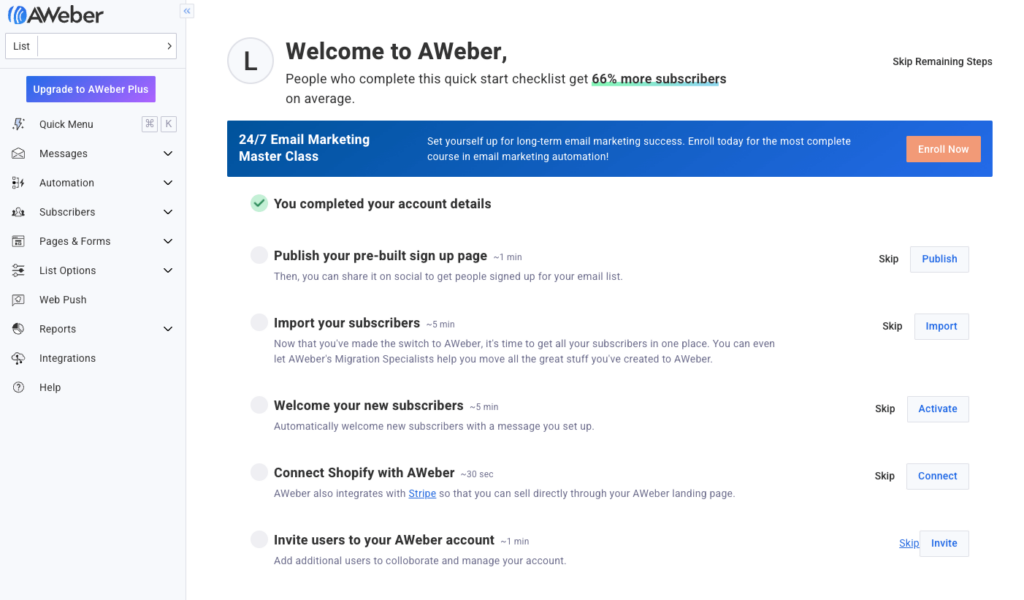
AWeber simplifies the signup process by not requiring a credit card initially. This allows users to explore the platform without any financial commitment. Meanwhile, Mailchimp asks for credit card information for a 30-day free trial. Providing personal information might deter some users.
AWeber makes finding all the necessary settings to start using the platform easy and intuitive. Things like changing the sender’s email address are a few clicks away.
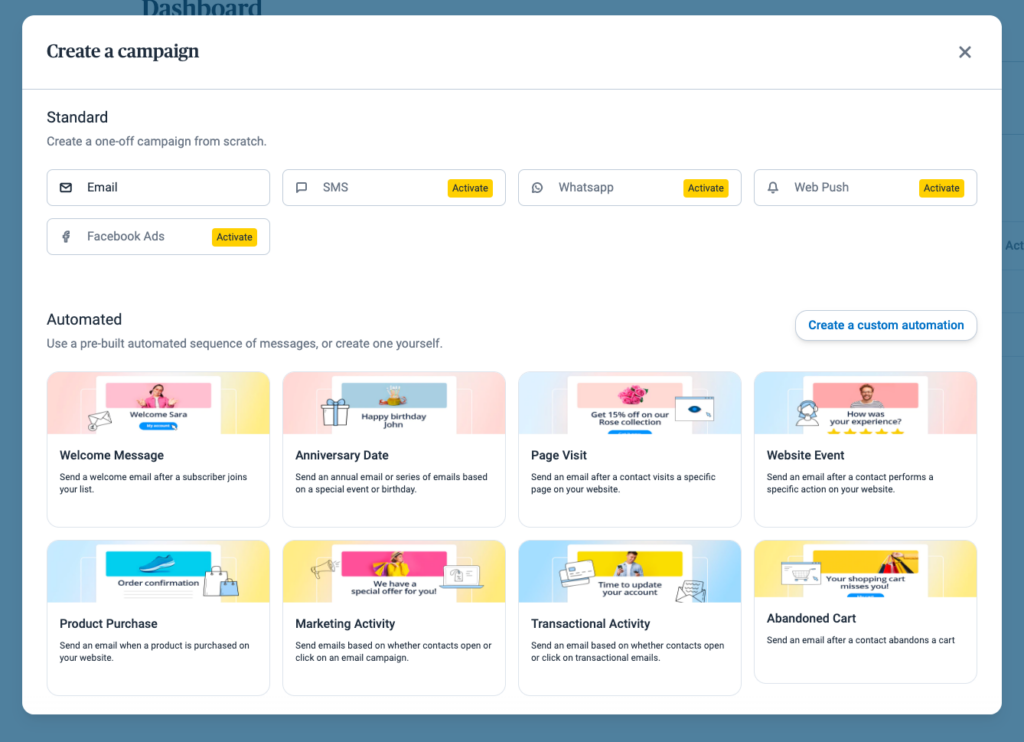
In contrast, Mailchimp’s extensive features make it difficult to find this option. We took considerable time exploring the platform to find it.
In terms of first impressions, AWeber’s menu appears clear. But certain terminologies could cause some initial confusion. For instance, using “broadcasts” for email campaigns, and “campaigns” for automation workflows might puzzle users.
In comparison, Mailchimp impresses with a clear and straightforward design. Their checklist for account setup is beneficial for beginners.
This round goes to Mailchimp. This platform is more intuitive, and the names of the main categories match industry standards.
Building an email campaign
If we had a top 10 rating for email builders, AWeber’s broadcast builder wouldn’t be there. Although it offers many content blocks, the overall experience isn’t as smooth as that offered by the email builders of other platforms.
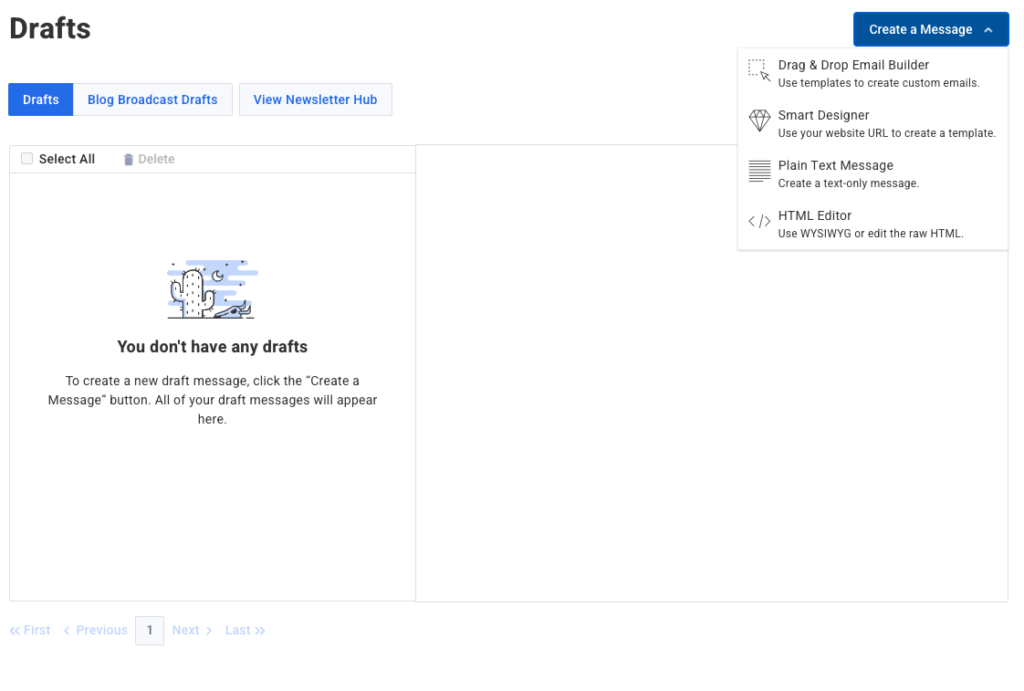
On the positive side, AWeber offers an image carousel and integrations with Canva and Unsplash. These features can help you improve your email design and add images if you don’t have many in your collection.
On AWeber, you will find 150+ email templates. Some of them look good, while others appear outdated.
Meanwhile, Mailchimp’s email campaign wizard is far more intuitive and clear. Mailchimp offers two email builders. There’s a classic and a new builder (beta), both highly intuitive and functional.
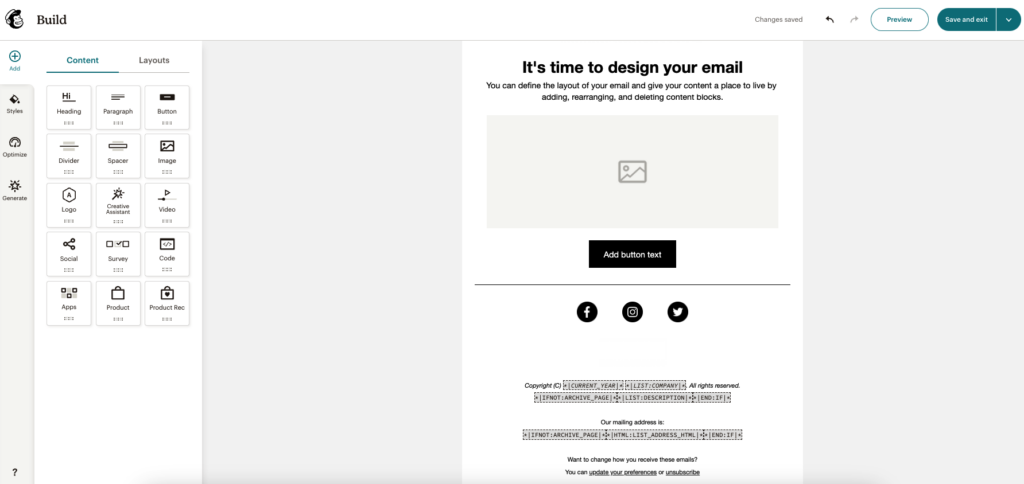
Mailchimp’s free plan offers only six basic email layouts. However, its paid plans provide tons of modern and appealing options.
Mailchimp stands out with its dynamic content block. You can also send postcards, create surveys, and receive subject line recommendations.
Additionally, Mailchimp offers 25 tokens of inbox previews on different devices. These are integrated with Litmus, but you’re charged extra for additional tokens.
While AWeber offers email scheduling on all plans, Mailchimp only provides it with paid plans.
Regarding personalization features, the AWeber vs Mailchimp contest results in a tie. Both platforms offer these features when building an email campaign. Users can easily insert contact details and customize subject lines and email content.
Mailchimp gains an edge with its more intuitive email campaign wizard. It has two user-friendly email builders and supports all email types.
Marketing automation
Both AWeber and Mailchimp offer marketing automation capabilities. But AWeber’s automation interface feels clunky. We didn’t find it as user-friendly as Mailchimp’s.
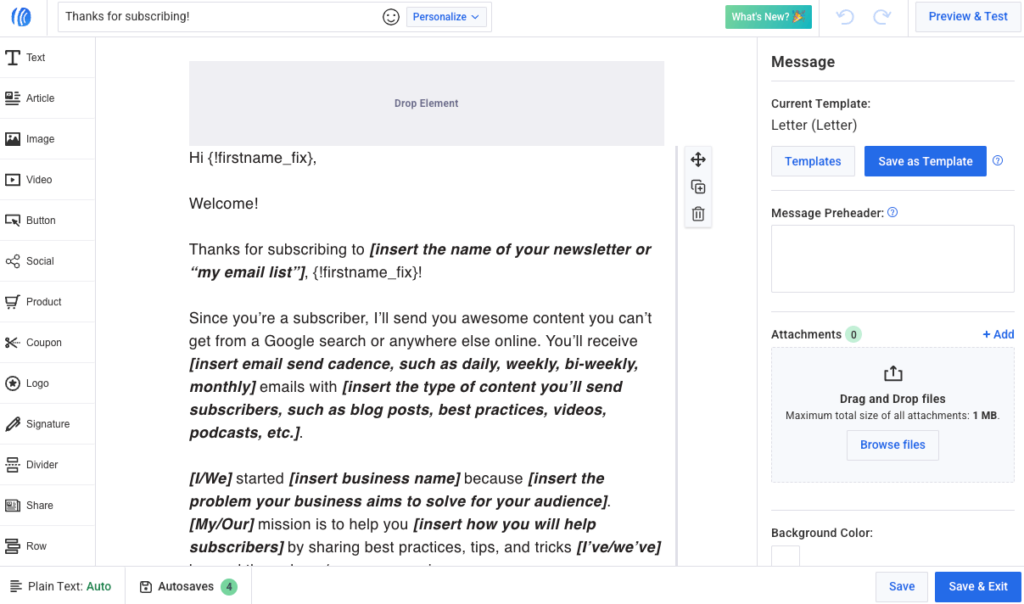
In general, the AWeber automation part isn’t bad. The platform provides prebuilt automation workflows. These include welcome series, blog notifications, emails for lead magnets, and mini-courses. In addition, there is an extended marketplace with more ready-to-use templates for most common ecommerce cases. Users need to edit these logic-ready templates and add content before launching them.
Mailchimp’s automation feature is easy to use, with over 70+ pre-built customer journey templates. Still, users must add content to most of these templates, as only the workflow structure is ready.
Regarding marketing channels integration into the workflows, AWeber doesn’t have any. Meanwhile, Mailchimp allows social media, and using 3rd party integrations (like Twilio, and Slack), you may also add SMS, live chat, and more.
How do AWeber and Mailchimp compare in terms of automation triggers?
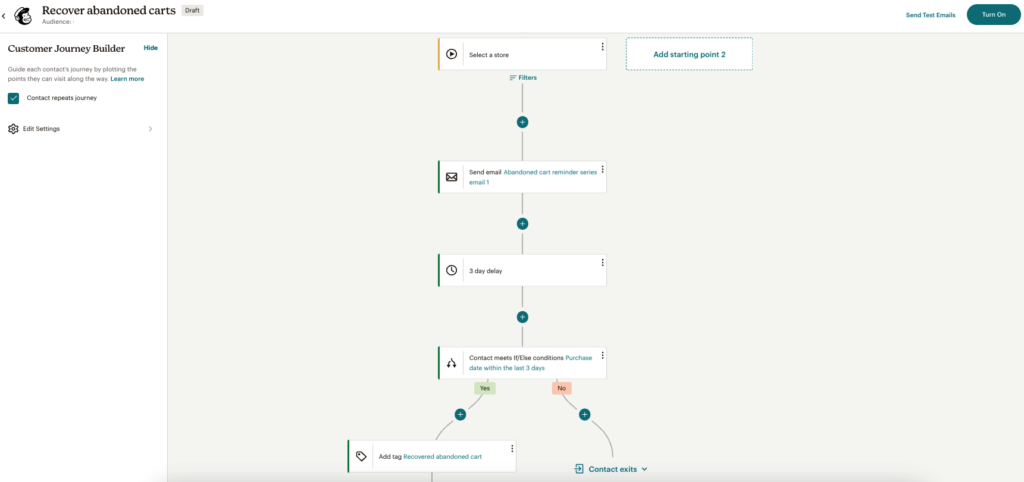
Mailchimp lets you create custom automation from scratch or use predefined workflows. You can trigger them by numerous criteria, including:
- Tags
- Dates
- Subscriber and purchase activity
- API calls
You can set up different goals for your automation workflow and save them as templates for future use. Also, Mailchimp’s paying clients get access to more versatile triggers.
Meanwhile, AWeber lets you create automated sequences using a drag-and-drop campaign builder. You can then deliver custom drip campaigns to your subscribers.
You can also send triggered email campaigns based on specific events, such as:
- Opens
- Clicks
- Purchases
It’s also possible to tag subscribers based on their actions to segment them further.
Compared to Mailchimp, AWeber’s triggers are relatively limited.
Mailchimp wins this round as its user interface is more user-friendly and offers more automation triggers than AWeber.
Signup forms and landing pages
Both AWeber and Mailchimp offer landing page builders with a drag-and-drop functionality to easily design landing pages. Both offer landing page templates to simplify the design process further.
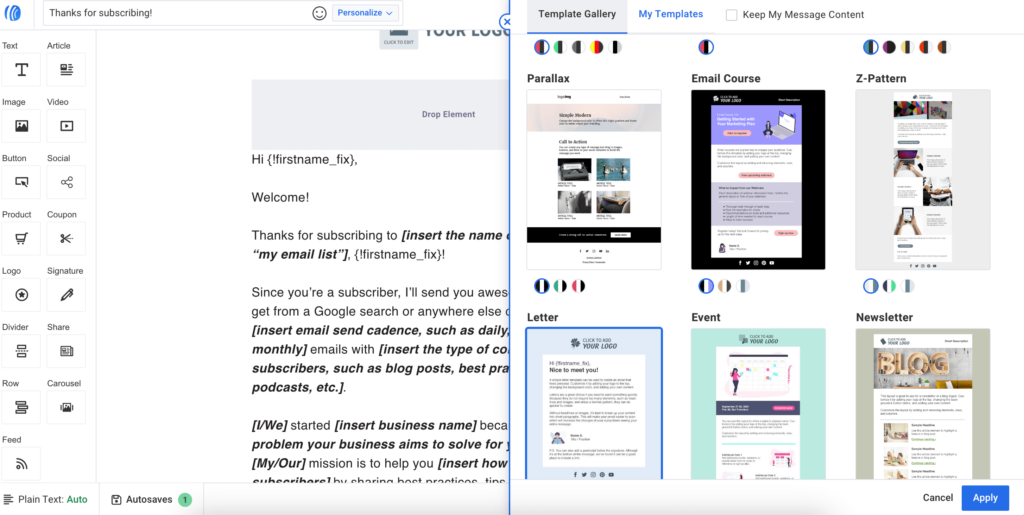
AWeber’s builder stands out with its ecommerce content block. This feature allows users to add a BUY button and sell directly from the landing page. A “Smart content block” automatically creates featured snippets for shared links.
However, AWeber’s builder could be smoother. We experienced some navigational issues when adding custom fields.
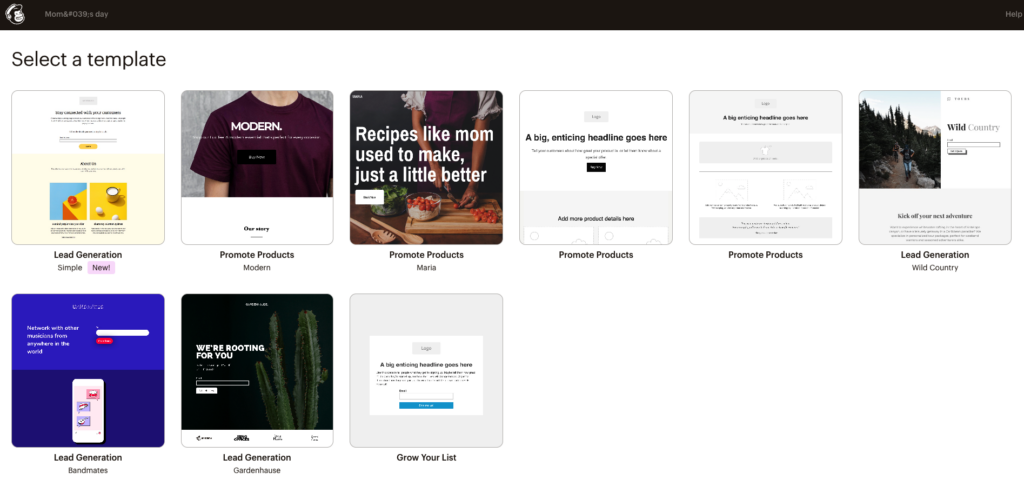
Meanwhile, Mailchimp’s landing page builder provides a smooth drag-and-drop experience. In fact, it’s one of the best builders we’ve seen on such platforms.
Now, let’s discuss their capabilities concerning signup forms.
Neither AWeber nor Mailchimp offers ready-to-use signup forms. AWeber does offer some for popups, though.
AWeber’s form builder is outdated and not easy to use, especially when compared to other platforms. You have to test various buttons and experiment to understand how the editor works.
It does, however, provide analytics for signup forms. AWeber reports let you get insights into the number of displays, submissions, and conversion rate.
Mailchimp’s form builder is comparatively better and offers various customization options to match brand colors and styles.
How easy is it to manage subscriber lists on these platforms?
Well, managing subscriber lists is quite easy on Mailchimp. You can easily segment users using tags and contact properties. The only drawback is its siloed subscriber lists.
If you have the same contact on two different lists, you’ll have to pay for them twice. This is an issue seen on very rare platforms, including Mailchimp. On AWeber, you will have to pay for unsubscribes.
As for AWeber, the contact import process is straightforward, but the platform takes a lot of time to process data. Though AWeber has a lot of good features, the outdated interface makes things difficult for users.
Mailchimp is the winner. Though both offer similar features, Mailchimp’s interface is much better than AWeber’s clunky and outdated interface.
Segmentation
Both AWeber and Mailchimp offer sufficient segmentation options and pre-built segments. But segmentation functionality depends on the plan you’ve signed up for on both platforms.
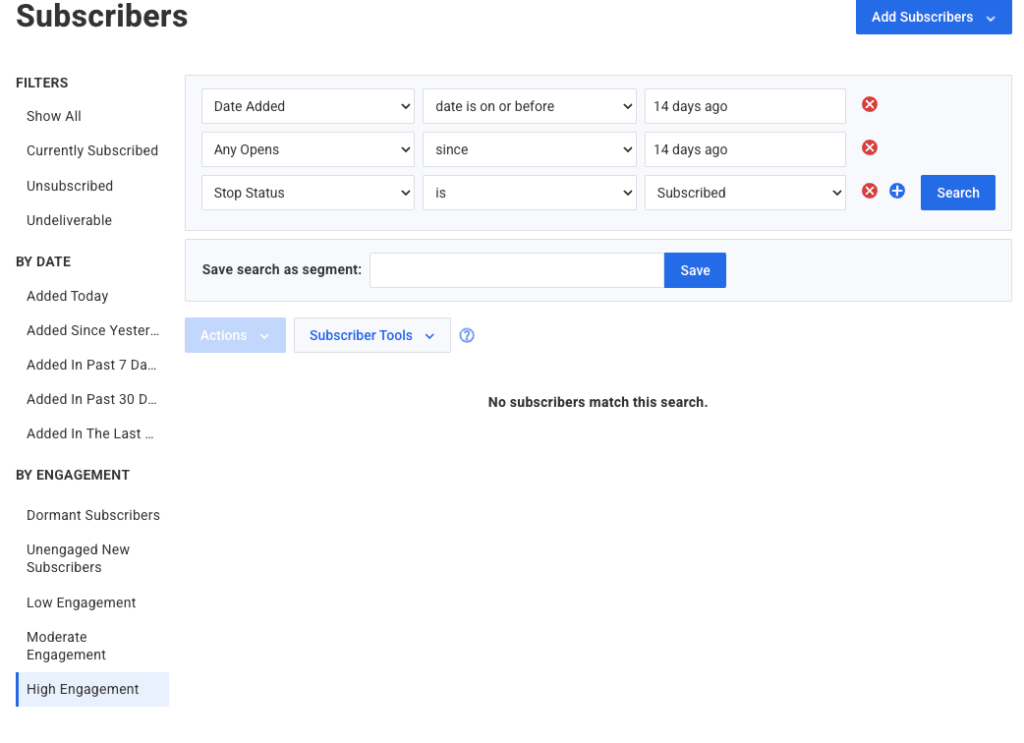
The following pre-built segments are available for all AWeber users:
- Dormant subscribers
- Unengaged new subscribers
- Low engagement subscribers
- Moderate engagement subscribers
- High engagement subscribers
The higher-tier plans offer custom segments with more advanced options. Users can segment based on various aspects, including email activity, shopping activity, contact details, and custom fields.
Meanwhile, Mailchimp offers three ready-to-use audiences, and its predictive segmentation is available for higher-tier plans only.
Each segment can include up to five conditions. These provide sufficient flexibility for most use cases.
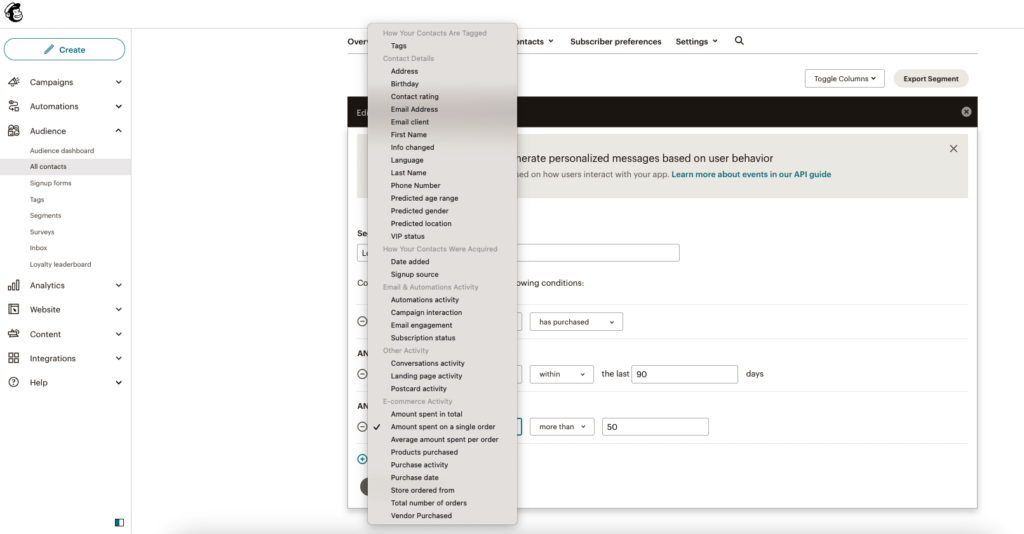
The available segment options include:
- Tags
- Conversations activity
- Automation activity
- Postcard activity
- Contact rating
- Location
Mailchimp wins again. Despite having five pre-built segments, AWeber’s segmentation features feel more limited. Meanwhile, Mailchimp has more robust segmentation capabilities, and a larger number of users can take advantage of these segmentation features.
Analytics
Both AWeber and Mailchimp allow users to track and analyze various email marketing metrics.
AWeber’s analytics allow users to view opens and clicks over time. It also provides data on new subscribers, automation metrics, the locations of subscribers, and sales over time.
Mailchimp’s analytics covers a wide range of metrics. You can get insights into open and click rates, social media engagement, landing page engagement rates, and information on forwarded campaigns.
AWeber’s higher-tier plans offer advanced analytics like email sales and webpage tracking. With Mailchimp’s premium plans, you get advanced features like comparative reports.
Unfortunately, both AWeber’s and Mailchimp’s analytics lack comprehensive ecommerce insights. These can be found in more advanced tools like Klaviyo and ActiveCampaign.
Mailchimp wins this round as it offers a broader range of tracked metrics and comparative reports.
Customer support
Both AWeber and Mailchimp offer various customer support options for their users. However, they have varying levels of support based on the customer’s plan.
For free plan users, AWeber provides 24/7 email and chat support. Meanwhile, Mailchimp’s free users can access email support only for the first 30 days.
For Aweber’s paying customers, there are:
- 24/7 email customer support
- Long hours live chat support
- USA business hours phone support
Mailchimp’s paying customers also get 24/7 email and chat support. Premium plan users enjoy priority support and the option to call for assistance.
Both AWeber and Mailchimp offer plenty of resources and tutorials. These include blog articles and videos.
AWeber’s knowledge base articles help users navigate and make the most of its features. Mailchimp’s tutorials go the extra mile. They teach users everything from starting, running, and marketing their business.
Lastly, both AWeber and Mailchimp have educational videos on YouTube.
AWeber takes the prize in this round as it offers better support to free plan users.
Integrations
When doing a Mailchimp vs AWeber comparison, we had to consider the various integrations each platform offers. After all, the more seamless your integrations with your tech stack, the easier things will be for you.
Both platforms offer integrations with a wide range of third-party tools and platforms.
For email marketing platforms like AWeber or Mailchimp, robust integrations allow you to:
- Efficiently manage customer data
- Reveal the full potential of their campaigns
- Expand their reach across multiple channels
- Foster success in the competitive landscape of the digital era
AWeber boasts an extensive library of over 700 integrations. These cover a wide variety of platforms, such as:
- Ecommerce platforms
- Content management systems
- Lead generation tools
- Productivity apps
- CRM software, and more
Meanwhile, Mailchimp offers a decent list of over 300 integrations. These cover analytics, contact management, booking and scheduling, ecommerce, and marketing platforms.
AWeber is a clear winner with its extensive library of 700+ integrations.
Compatibility with other marketing channels
Both AWeber and Mailchimp are compatible with other marketing channels and platforms. This helps their users extend their reach beyond email marketing. But, they differ in the specific channels and availability of integration options.
AWeber offers compatibility with Facebook lead ads. Users can integrate their email marketing efforts with lead-generation campaigns on Facebook. This platform doesn’t offer native SMS marketing, but you can do it with additional integration.
Meanwhile, Mailchimp provides integration with Facebook, Instagram, and Google Analytics. SMS marketing is new on Mailchimp.
Both AWeber and Mailchimp don’t offer native push notifications integrations.
Mailchimp takes the lead as it has a better compatibility with SMS, Facebook, Instagram, and Google Analytics.
Price Comparison
Now, let’s dive right into the AWeber vs Mailchimp price comparison. We’ll look into the free (or trial) and paid plans offered by the two platforms.
So, which email marketing platform is more affordable: AWeber or Mailchimp?
Let’s find out.
Free plans comparison
Both AWeber and Mailchimp offer free plans. However, the features offered in these free plans differ between the platforms.
AWeber takes the lead. Its free plan allows for a higher number of monthly emails and subscribers. AWeber also has ongoing chat and email support for its free plan users. Mailchimp cuts support after 30 days.
Paid plans comparison
Both AWeber and Mailchimp offer three paid plans. AWeber has Lite, Plus, and Unlimited plans. Meanwhile, Mailchimp has Essentials, Standard, and Premium plans for its marketing platform.
AWeber’s Unlimited plan is a fixed-price plan for clients with over 100,000 subscribers. It costs $899 per month.
As for Mailchimp, it offers different pricing plans based on these use cases:
- Transactional emails
- Website and commerce
- Marketing platform
- Pay-as-you-go plan
Here’s a quick AWeber vs Mailchimp comparison in terms of paid plans.
Both AWeber and Mailchimp offer valuable features. However, there are some distinctions in their offerings based on plan tiers.
AWeber provides several essential features exclusively with its paid plans, these include:
- Reporting
- Email split testing
- Deliverability reporting
- Facebook pixel tracking
Paid users also get advanced features like behavioral automation and advanced landing pages. This makes it a compelling option for those willing to invest in email marketing.
Mailchimp also reserves certain features for its paid plans, including email templates. The higher-tier plans unlock more advanced capabilities like:
- Pre-built customer journeys
- Predictive segmentation
- Send time optimization
Mailchimp’s tiered pricing structure caters to businesses with specific needs. However, it gets expensive if you want to exploit the platform entirely.
AWeber wins this last round of AWeber vs Mailchimp comparison as it’s more affordable.
AWeber vs Mailchimp: Which one’s better?
Is it going to be Mailchimp or AWeber? Before we render our final verdict, let’s recap the two platforms’ pricing and features.
3.5
4.5
Free plan – Yes
500 subscribers – $15
5,000 subscribers – $45
10,000 subscribers – $65
50,000 subscribers – $388
Free plan – Yes
500 subscribers – $13
5,000 subscribers – $75
10,000 subscribers – $110
50,000 subscribers – $385
- Robust landing page builder
- Lots of integrations
- User-friendly interface
- Extensive range of features
- Easy to use
- Not the best user experience
- Includes unsubscribers in your monthly quota
- Charges for email duplicates (same subscriber in different lists)
- Limited free plan, with paid plans getting expensive quickly
- Corporate organizations needing conservative, stable solutions
- Bloggers
- Startup
- Solopreneurs
- Non-profit organizations
- Bloggers
- Growing ecommerce businesses
- Nonprofit organizations
- Ecommerce sites in their active growth stage
Mailchimp excels in building an email campaign and marketing automation. It also offers more robust segmentation capabilities.
However, AWeber offers easier onboarding and superior customer support. It also has far more extensive integrations and better pricing.
Whether you choose AWeber or Mailchimp depends on your budget and priorities.
But if your focus is on ecommerce, we recommend tools like GetResponse or Omnisend. These platforms provide omnichannel marketing to increase reach and engagement. Its features include advanced segmentation, analytics, and detailed reporting.
Read full reviews
Related picks for you
Our team strives to be accurate and unbiased in reviewing email tools. However, we recognize that mistakes can happen, and it’s essential for us to stay up to date. If you come across any errors or things that need to be reviewed again, please let us know.





Leave a Reply